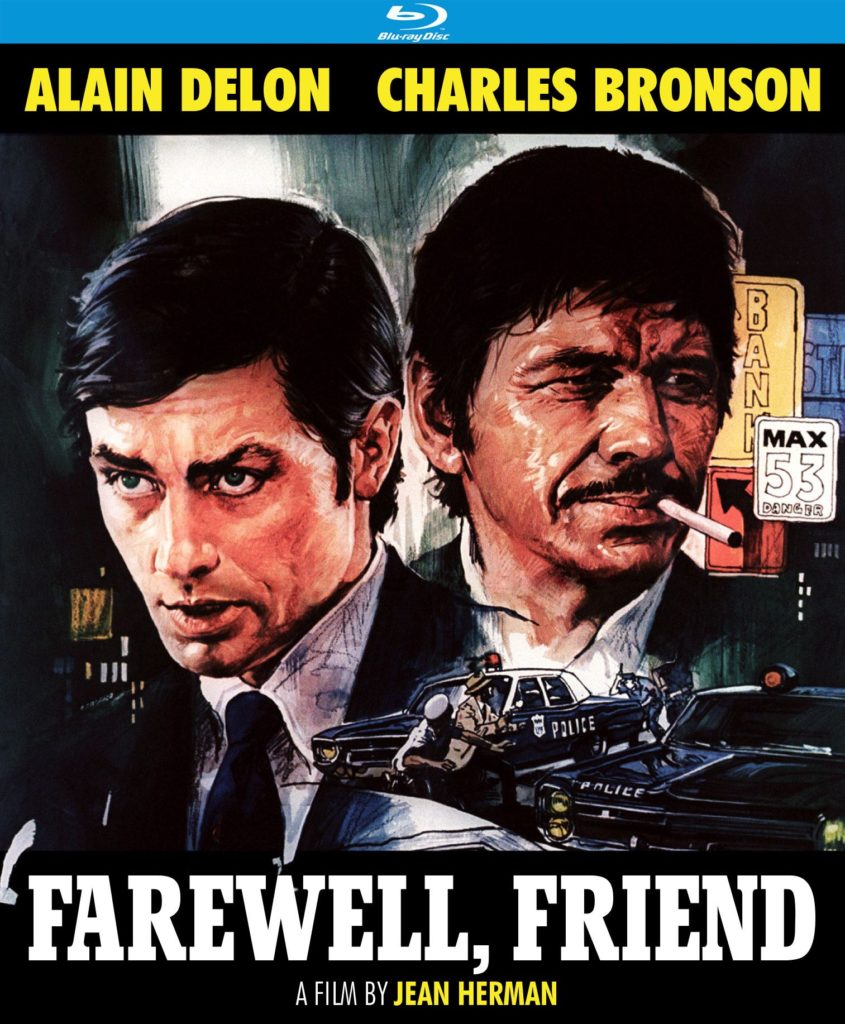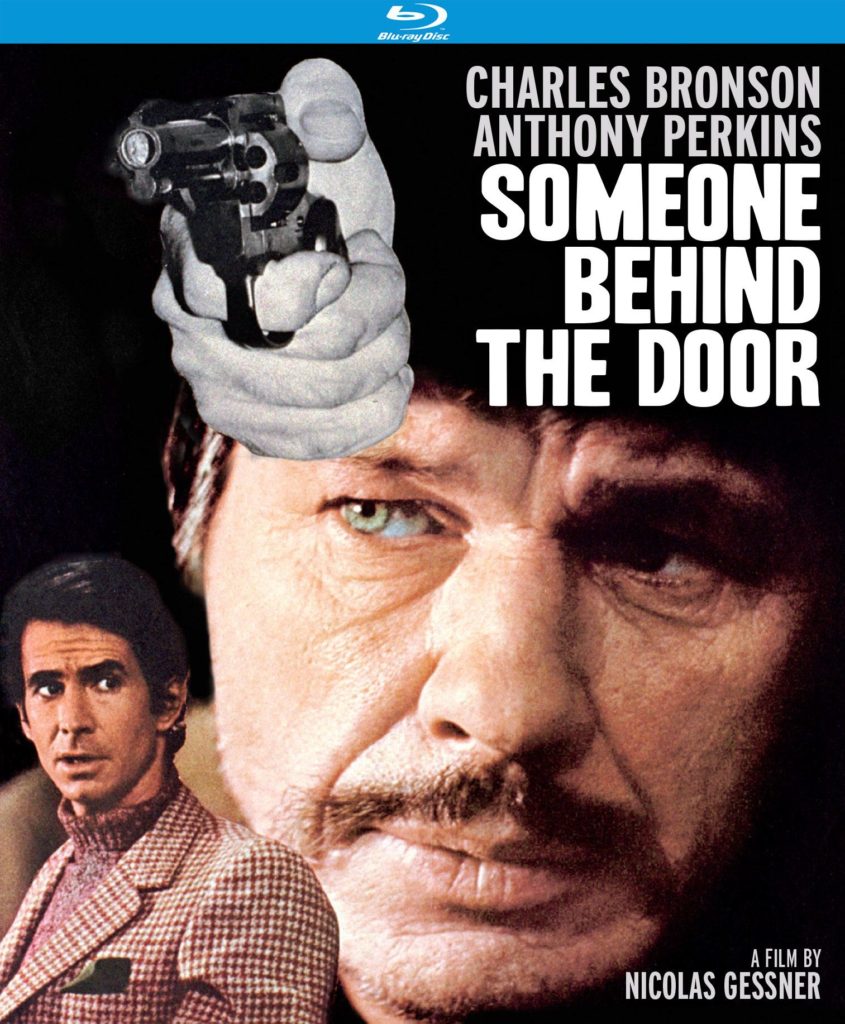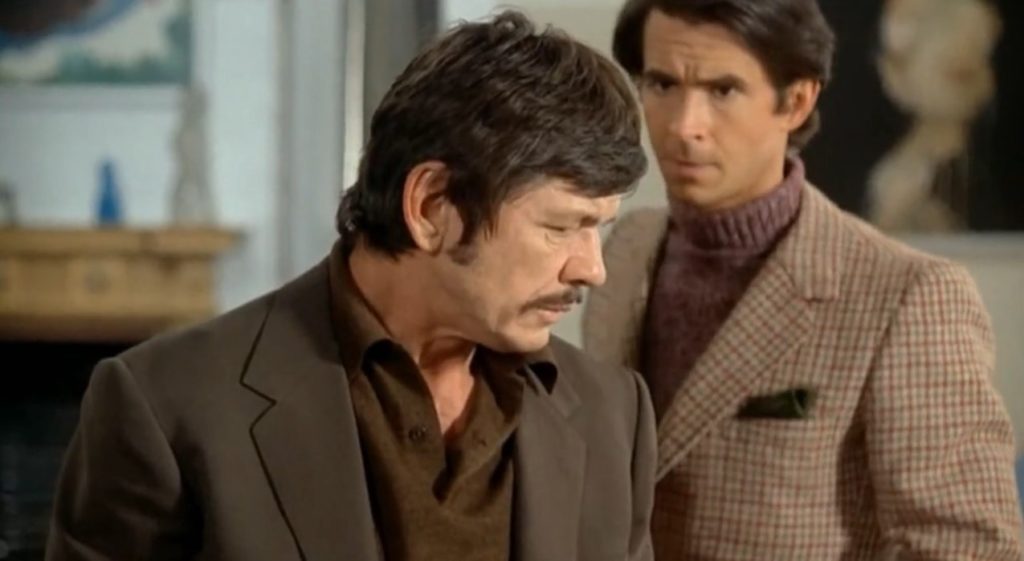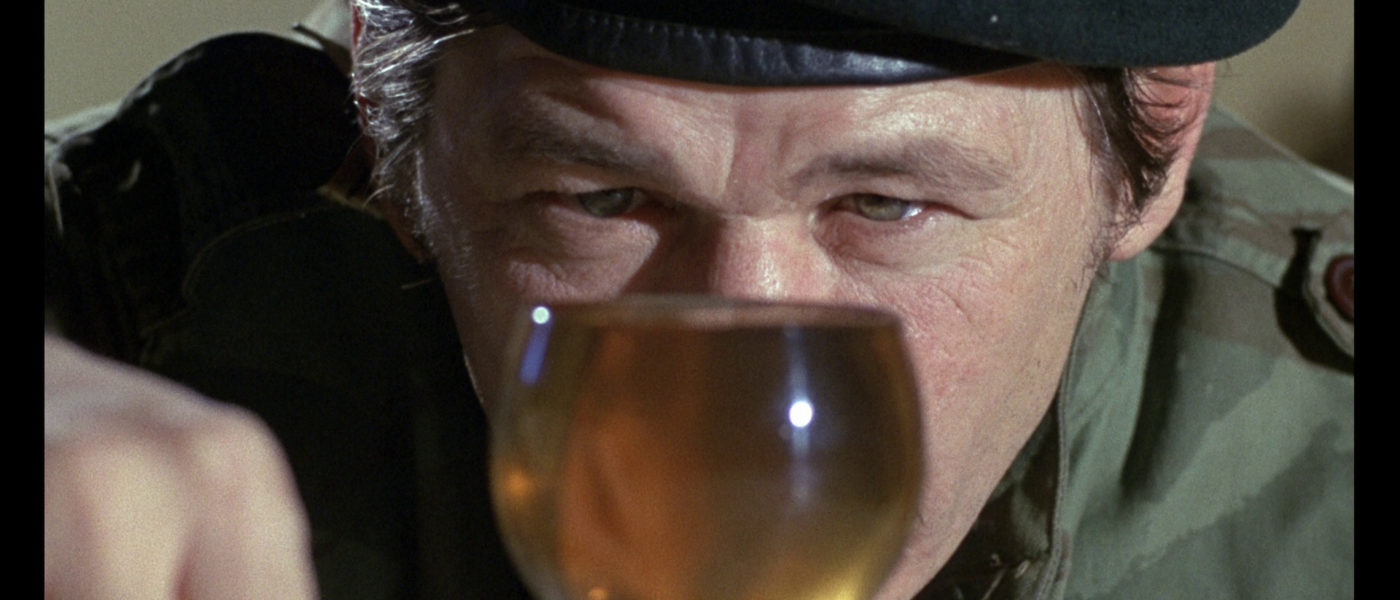Bronson Bursts Onto International Scene In Bookending European Thrillers
FAREWELL, FRIEND (1968)/FRENCH-ITALIAN/DIRECTED BY JEAN HERMAN

SOMEONE BEHIND THE DOOR (1971)/FRENCH-ENGLISH-ITALIAN/DIRECTED BY NICOLAS GESSNER

STREET DATES: November 19th, 2019/KINO LORBER STUDIO CLASSICS
Born Charles Buchinsky in November 1921, this child of Lithuanian parents built his rock-solid physique as a young laborer in the Pennsylvania coal mines and was awarded the Purple Heart for wounds received from active, heavy service as a bombardier in the Pacific Theater of the Second World War. Turning to acting after an early life of hard work and adventure, Buchinsky made memorable if far-flung appearances in such varied fare as Pat and Mike (1952), House of Wax (1953), and Apache (1954) — as gangster, mute henchman, and Native American warrior, respectively — before Charles Bronson, as he became known by the mid-1950’s, played the title lead Roger Corman’s low-budget Machine-Gun Kelly (1958), and raised his profile considerably with several prominent roles on the small-screen, including his record five guest shots (in different roles) on the acclaimed CBS Western Have Gun – Will Travel (1957-1963).
Building on a pair of well-remembered supporting parts in director John Sturges’s The Magnificent Seven (1960) and The Great Escape (1963), Bronson inarguably stole the entire proceedings from another multi-cast range of legendary heavyweight actors, including John Cassavetes, Telly Savalas, Robert Ryan, George Kennedy, and the redoubtable Lee Marvin, in director Robert Aldrich’s trend-setting mega-smash The Dirty Dozen (1967). Seven years later, in director Michael Winner’s era-defining Death Wish (1974), Charles Bronson at the age of 52 found the vengeance-seeking, violence-prone anti-hero that would extend to his lengthy and lucrative association with Cannon Film Group (the Death Wish sequels [1982-1987], 10 to Midnight [1983], Murphy’s Law [1986]) throughout the 1980’s.
…
Or so goes the narrow narrative of Charles Bronson’s astonishing, and often undervalued, film career. In between his starring role as “Harmonica”, the Man of Few Words in Sergio Leone’s Once Upon a Time in the West (1968), and his title role as real-life Mafia turncoat Joe Valachi of The Valachi Papers (1972, dir. Terence Young), Bronson’s run of starring and co-starring roles in several European productions developed the understated strength and apparently effortless realism the actor had cultivated with surprisingly subtle sensitivity in earlier supporting appearances, which had been particularly resonant in the mid-1960’s dramas The Sandpiper (1965, dir. Vincente Minnelli) and This Property is Condemned (1966, dir. Sydney Pollack).
Indeed, it was the actor’s difficult if small-ish role in the latter adaptation of a Tennessee Williams one-act that coincidentally, or perhaps serendipitously, resonated with French directors Jean Herman (later popular French novelist Jean Vaturin) and Nicolas Gessner (1976’s cult-item The Little Girl Who Lives Down the Lane). In this offbeat film, and as the even more offbeat character, Bronson plays a laid-off railroad worker during the Depression who boards at a dilapidated Southern inn, romancing the aging innkeeper played by Kate Reid while also lustfully pursuing her floozy-dreamer daughter Natalie Wood. The dramatic difficulty of that emotional tight-spot is further compounded when Bronson’s character savagely attacks Wood’s developing romantic interest in Robert Redford’s railroad agent, and then must turn around a few screen sequences later and marry Woods’ drunkenly despairing character, despite his character realizing that the desperately boozy act is mere emotional revenge against Woods’ jealous mother.
The most remarkable part to this melodramatic hodgepodge, and its almost unplayable character, is how honest, sincere, and even unapologetic these rapidly shifting emotional and dramatic currents run; and it is made mainly believable by Bronson’s underplaying of a minor character whose crucially inciting actions appear moment-by-moment instinctive and in-the-moment assured. Regarding the pair of European-produced Bronson thrillers we have yet to get to, then, the screen strength that significantly dominated despite often appearing in less than a quarter of a given film’s running-time — extending to a character long-remembered after the nominal leading roles are forgotten — was utilized full force by the international producers and filmmakers who first recognized the actor’s granite-hewn appeal on a larger scale. In bookending productions from the actor’s overlooked European period, Kino Lorber presents two films on Blu-ray, released on the 98th anniversary month of the actor’s birth, that fully exhibit the actor’s easily overlooked versatility.
FAREWELL, FRIEND (1968, DIR. JEAN HERMAN)

Opposite screen icon Alain Delon, Bronson in his first (co-)starring international production parlays the understated poetry of its original French title Adieu l’ami to the familiar address of its English translation, Farewell, Friend. Re-titled Honor Among Thieves for its long-delayed English-language re-issue, director Jean Herman, who had made one previous feature after several documentary shorts, upsets the more conventional expectations of its redrafted title for character associations that blithely subvert traditional character roles developed between buddy-action protagonists. In Farewell, Friend, Bronson and Delon’s Algerian war veterans-turned-holiday weekend safebreakers transform fierce rivalry into mutual identification with one of the most climactically intimate cigarette-lightings ever captured in a male-costarring action-thriller.
Disembarking from their respective tours-of-duty as the films open, medical doctor Dino Barran (Delon) and infantryman Franz Propp (Bronson) find their postwar paths crossing in unusual ways, despite their shared loathing. Ensconcing himself with the promotional division of a manufacturing firm, where he daily conducts employee physicals, the scheduled routines of Dr. Barran, held efficiently to course by his deceptively mousy assistant Domnique (Brigitte Fossey), starkly contrasts with the shady schemes and shadier dealings — gamely encompassing financial and sexual exploitation when organizing a revolving garage-park strip-tease in one memorable scene — of Franz Propp.
Unknowingly linked by a mystery woman named Isabelle (Olga-Georges Picot), the invisible cord binding Barran and Propp tightens upon a nearly one-hour, underground sequence where the fractious pair — Barran plotting to replace stolen bonds to the very safe that Propp intends to rob — are trapped in a security-monitored basement over the three-day weekend of the Christmas holiday. Eventually locked in a pressure-controlled chamber without water, reduced to setting the rolled bonds on-fire for light and bashing metal room fixtures through a concrete wall to a narrow airshaft, Barran and Propp’s growing bond of friendship in the airless room — stripped to their waists in the unbearable heat — contributes to the added resolve of their miraculous escape.
Upon their emergence to safety, however, the newly bonded pair find themselves framed for the murder of a security guard killed in the course of the office building’s actual robbery. As yet unaware of their manipulation(s) at the hand(s) of a deadly combined higher intelligence, Barran takes unknowing refuge in the Baroque, expensively-furnished dragon’s lair of his former assistant Dominique, whom he learns not only has a theretofore-unknown association with Isabelle but also the foreboding nickname of “Waterloo”; while Prop, taken into custody after his dramatic capture at Orly Airport, succumbs to the wily machinations of eccentric police inspector Antoine Mèloutis (Bernard Fresson). Although neither newfound friend will betray the other, their respective fates are sealed — imprisonment on Propp’s end, compromised evasion on Barron’s — as the inspector leads all participants back to the scene of the crime for the film’s variously (and variantly) violent outcomes.
Under Herman’s direction, Bronson and Delon’s title Farewell or Adieu — the former lighting the latter’s last cigarette as a free man without either acknowledging, to the police or themselves, the now unbreakable link between them — is as simultaneously hilarious, deepfelt, and indeed complicated as the entire film is delightfully opaque, offbeat, and resonant. From the opening crane-shot of soldiers filing off the vast steamer in gray-and-red rows through the perversely persistent visual metaphors sexually reducing women to dolls to the unmistakable subtext of sweat glistening off Bronson and Delon’s straining torsos, the not-quite-romantic angle of this not-so-expectedly-exciting thriller, in which the protagonists are in fact entirely innocent of the central crime(s) committed, makes for 115-minutes of apparently meandering but actually quite tightly-scripted and visually-constructed genre subversion.
Ultimately proving his indispensable indomitability opposite his co-star’s accustomed sangfroid, Bronson’s squinty-eyed realism imbues his climactic, Cheshire-grin Farewell with as memorable a screen-punctuation as his co-star’s lung-bursting “Yee-ahhh!”
SOMEONE BEHIND THE DOOR (1971, DIR. NICOLAS GESSNER)

Released at the tail-end of the actor’s Europeon period, in the year after René Clément’s Rider on the Rain (1970) made him a huge star about everywhere except the United States, Bronson shows his effectiveness in a role that was in no way tailor-made to his tense-and-terse screen persona. In fact, the unknown, unnamed character calls for Bronson to play precisely against his trademark self-containment and, as such, is among the most adventurous roles the actor ever essayed.
As in the year-earlier film, where he convincingly played a charming Cary Grant-type in the Hitchcockian romantic thriller-mode of North by Northwest or of director Stanley Donen’s Charade (1963), Bronson as the mysterious figure Behind the title Door keeps the audience guessing through 93 minutes of screen time how his character will act (or react) to the personally untoward developments of its twisty-turny plot. Also dissimilar to many Bronson roles both before or after (with possible exceptions to his direct manipulation by clever women in the former film, and later in such Hollywood fare as From Noon Till Three and St. Ives [both 1976]), the amnesiac “stranger” of 1971’s Someone Behind the Door surrenders and indeed subordinates himself to the malevolent manipulation of a more powerful male character.
In self-possession and emotional confidence, that is. Creepily essaying his shifty hold over a weaker psychology is the incomparable Anthony Perkins as Dr. Laurence Jeffries, an American brain surgeon living in coastal England who specializes in trauma-related injuries. After examining a wandering and confused man (Bronson) at his hospital, with few clues to the man’s identity beyond vague memories of a violently sexual (and possibly murderous) encounter with a woman on a beach, Jeffries brings the amnesiac to his seaside home, ostensibly for further study and research.
Sedating the man with a few orange juice-dissolved pills, Jeffries locks him in the first-story guest room before retiring to the domestic drama transpiring above in his vast house’s second-story master bedroom. Waking the next morning to his beautiful wife Francis (Jill Ireland) taking a bath, their seemingly casual bedside and breakfast conversation reveals strange undercurrents of work-and-study-related neglect on his part and open infidelity on her’s. Preparing for her usual weekly cross-channel trip, with the thin alibi of her brother Andrew (Adriano Magistretti) the supposed object of her visit, Jeffries narrowly deters Francis, just before her departure, from opening the locked room where the amnesiac sleeps.
The afternoon after his wife has gone, Jeffries begins a subtle program of mental suggestion over the course of a few hours on his awakening amnesia patient, gradually convincing the stranger through an accumulation of ‘clues’ planted in a suitcase later ‘found’ on the nearby beach — containing a stylish wardrobe, a love letter addressed to a man named Paul Damien, and a nude female photograph we immediately recognize as Francis — that he, the amnesiac, is married to Dr. Jeffries’ wife. Grafting his personality, memories, and particularly his knowledge of Francis’s affairs — in the person, we learn, of the letter’s actual addressee, French journalist Paul Damien (Henri Garcin) — the Machiavellian mental maneuverings of a brilliantly jealous husband finally resolve to another violently murderous (and unequivocally sexual) encounter between a cheating wife, her secret lover, and the stranger Behind the Door.
Who is the stranger? Beyond a newspaper headline and a police pursuit suggesting an escaped mental patient prone to rape-murder (which is oddly resonant with the shocking opening sequence of 1970’s Rider on the Rain), we know and come to know nothing else of the character beyond the direct evidence of the screen. As such, the third personality created between Perkins and Bronson — with Perkins pushing Bronson towards an otherwise motiveless act the former himself may not be directly capable of — becomes first a story-manipulated cipher and second a plot-driven device, a Frankenstein mental-monster unleashed by its creator.
Or perhaps a dreamlike open canvass, psychologically suggestive of movie-watching? Whatever the case, in his playing of an essentially unplayable character, uncharacteristically subject to difficult emotions, insecurities, and indirect modes of expression beyond the immediately proactive, Bronson — despite his latterday reputation — just goes for it. Throwing temper tantrums, behaving impulsively, registering uncertainty and even fear, we may not recognize the stranger as Bronson, but we understand qualities of emotion and personality the actor is not well-known for, but is here considerably equal to expressing.
Shooting exteriors on-location in Folkestone, England and on sets in Paris, France — with supporting players and extras cast mainly from Italy, apparently — director Nicolas Gessner draws together the production’s heterogeneous, international elements for its seamless albeit unusual iteration of the psychological thriller. With a savage and desperate man driven to choking the life from his female victim as his horrified tormentor gazes fascinatedly on, Gessner’s pairing — and climactic superimposition — of Perkins and Bronson is nothing less than inspired.
…
Sitting down with this pair of hitherto unseen movies, bookending international productions from an underseen (and undervalued) period of a major star’s considerably varied oeuvre, it is quite interesting to note that despite his lone wolf reputation how Charles Bronson so effectively shares the spotlight with his two co-stars in Farewell, Friend and Someone Behind the Door. Remarkable for both its unusual development in the former and its antagonistic sympathy in the latter, both films find a level of interaction between equal-billed characters — movie-male relationships, one might add that are neither easy to describe nor to casually dismiss — that essentially puts the lie to the narrow critical notion that Bronson was solely capable of playing the strong-and-silent type.
Rather, coeval with both Delon in Farewell and Perkins in Door, Bronson finds a resonant rapport with non-female characters that is as exciting and interesting as his intimate and indeed vulnerable relationships with contemporary co-stars Marléne Jobert (Rider on the Rain) and Liv Ullmann (1971’s Cold Sweat).
Far from the numerous post-1974 Death Wish iterations of the monosyllabic killer cemented (and indeed dismissed) in the critical consciousness, a greater awareness of the actor’s 1968-1971 European period will one feel actually illuminate the realer-than-life complexities hiding in plain sight — squinting out through cloudy blue or cold green eyes (depending on the lighting and/or color timing) — to his haunted Wild Bill Hickok hunting the White Buffalo (1977), or his more manipulated than manipulating P.I. in St. Ives (1976), his morally compromised Russian agent hopelessly in love with a doomed double-(possibly triple-)agent in Telefon (1977); or what this reviewer considers his masterpiece of few words and greater strength, the Depression-drifting streetfighter of Hard Times (1975).
Or virtually anything Bronson appeared in. Never less than real, Bronson simply is on-screen; as able to inhabit a character as to bring out the essential qualities of another actor.
…
Before we descend/ascend into complete Bronson-apologia, however, a few words on Kino Lorber’s pair of Blu-rays. Giving as complete a view as could be hoped for of these previous rarities, often re-titled and indifferently presented from inferior source material, both Farewell, Friend and Someone Behind the Door are directly transferred from prints licensed from Studiocanal. The respective texture of the images effectively captures the leathery lines of Bronson’s skin (including the tanned glow of his inevitably shirtless upper body) as well as the bravura lighting of confined spaces — a parking garage, locked chambers, an air-shaft — in Farewell, Friend and the repeatedly sinister pour of sallow, drugged orange juice in Someone Behind the Door.
Going further into the discs’ special features, Farewell, Friend includes a lengthy interview, filmed in 2004, with director Jean Herman, who covers the entire production of the film from its genesis with screenwriter Sébastien Japrisot through its (hilarious) search with producer Serge Silberman for a co-star for Alain Delon in 1967 Hollywood to its low-budget but highly imaginative filming of Parisian locations, on repurposed sound stages, and in an actual office building. Diving deeper into the unusual but involving quality of this buddy film-cum-art thriller, commentator favorites Howard S. Berger, Steve Mitchell, and Nathaniel Thompson return to their familiar terrain of the European-displaced Bronson film — following their earlier commentaries for 1970’s Rider on the Rain and 1971’s Cold Sweat —for the very first among this cycle of films, analyzing at length the many-layered complexities of the central characters’ relationship, the innovative and (purposefully) meandering construction of the plot, and how both contribute to the many effective shocks and surprises of the film’s final act.
Dovetailing on director Nicolas Gessner’s charming feature-length commentary included with the Blu-ray of Someone Behind the Door, Howard S. Berger’s insight that Bronson as an actor seemed to thrive on conflict with his director, Gessner’s occasional and one might say dangerous provocations of the not-to-be-trifled-with actor seems to have drawn one hell of a fine Bronson performance.
Hollywood soon beckoned, and Bronson returned a supporting player no longer, but his bookending European thrillers are still as eye-opening for home viewers seeing them today as they were for non-US audiences, for whom the actor then held the status of international treasure. On Blu-ray, one hopes there might be a similar, if belated, latterday recognition of the actor’s versatility and talent well beyond his ability to hold a frame with those steel-blue (or iron-grey?) eyes.
The featured image and still taken from Farewell, Friend are credited to DVDBeaver and are taken directly from Kino Lorber’s Blu-ray. The still from Someone Behind the Door is used only as a reference to the film and is not meant to represent the image quality of Kino Lorber’s Blu-ray. Thanks to Kino Lorber for providing review copies of both films.


